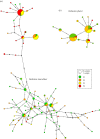Contrasting evolutionary responses in two co-distributed species of Galaxias (Pisces, Galaxiidae) in a river from the glaciated range in Southern Chile
- PMID: 32874654
- PMCID: PMC7428232
- DOI: 10.1098/rsos.200632
Contrasting evolutionary responses in two co-distributed species of Galaxias (Pisces, Galaxiidae) in a river from the glaciated range in Southern Chile
Abstract
Life-history traits are among the most important factors affecting population abundance and genetic diversity of species. Here, we analysed the genetic patterns of two Galaxias species with different life-history traits to investigate how these biological differences impacted their evolution in the Valdivia River basin, Southern Chile. We analysed mitochondrial DNA (mtDNA) sequences from 225 individuals of Galaxias maculatus and 136 of G. platei to compare patterns of genetic diversity, structure and demographic growth across the basin. Galaxias maculatus presented higher genetic diversity and higher genetic structure than G. platei. Demographic analyses showed G. maculatus kept a higher population size over time, with a signal of demographic expansion in the last 250 kyr. Whereas Galaxias platei, exhibited lower, but constant population size over time. Furthermore, haplotype networks revealed higher lineage diversity in G. maculatus with a tendency to occupy different areas of the basin. Coalescent simulations ruled out that genetic differences between species could be explained by stochastic processes (genetic drift), suggesting species-specific biological differences as responsible for the observed genetic differences. We discuss how differences in life-history traits and past glaciations interact to shape the evolutionary history of the two Galaxias species.
Keywords: Last Glacial Maximum; comparative phylogeography; freshwater fishes; genetic variation; idiosyncratic responses.
© 2020 The Authors.
Conflict of interest statement
The authors declare no competing interests.
Figures




References
Associated data
LinkOut - more resources
Full Text Sources
Miscellaneous

